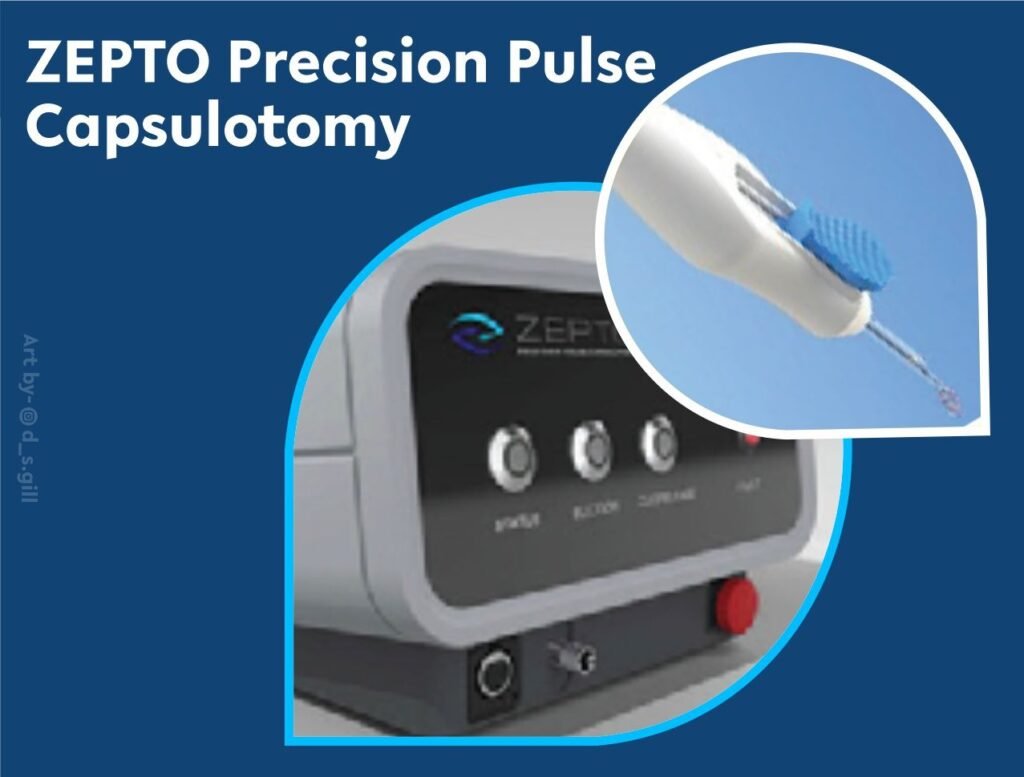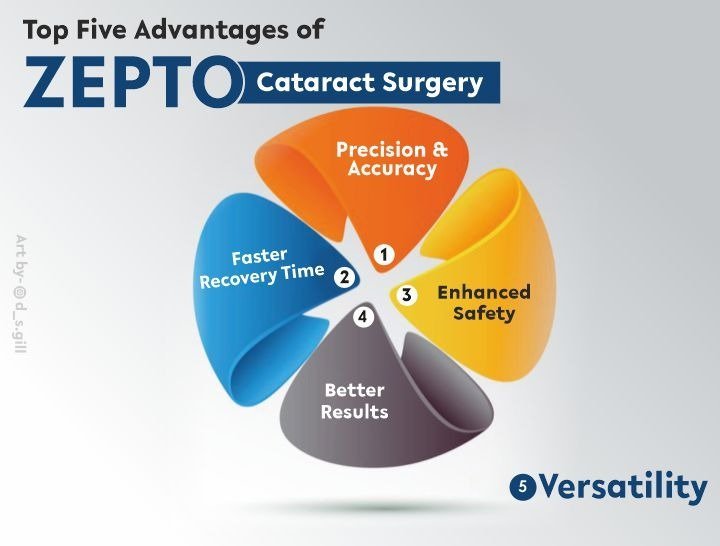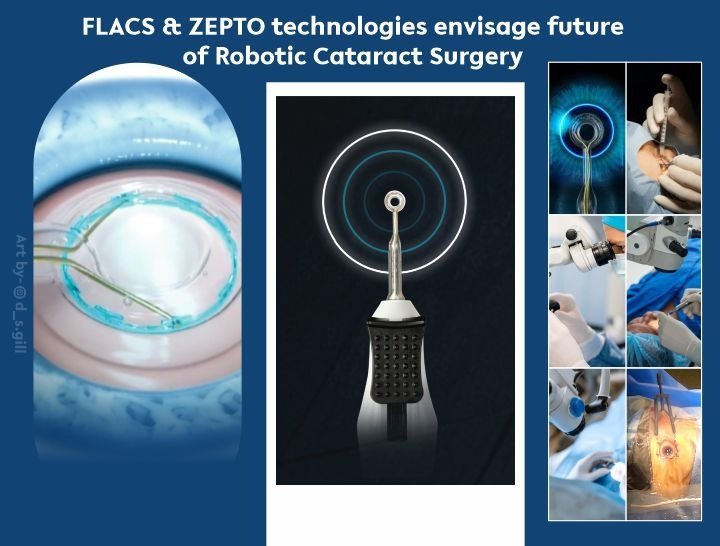Cataract surgery (Motiabind Operation) is arguably the most commonly performed eye surgery worldwide. In recent years, Cataract surgery procedures have become faster and more comfortable, with near-instant vision restoration after the Surgery. With the intervention of robotics and artificial intelligence, cataract removal has turned out to be all the more convenient. Cataract patients no longer have to live with long recovery times and dubious results as new technologies are changing cataract procedures as never before. A new benchmark for accuracy, safety, and patient satisfaction has been set by the advent of robotic cataract surgery, which includes the latest cataract technologies like FLACS (Femtosecond Laser-Assisted Cataract Surgery) and ZEPTO (Precision Pulse Capsulotomy)
To gain an authentic understating, better perspective, and expert insights about these robotic cataract procedures, we spoke to Dr. Kashish Gupta, a robotic cataract specialist & Chief Eye surgeon at the Max Hospital Bathinda in Punjab, India. This blog article will take you through the advantages of ZEPTO Ziemer Precision Pulse Capsulotomy) and FLACS (Femto Laser-assisted Cataract Surgery) techniques in modern cataract surgeries and how they are going to be the future of cataract surgery. The blog also features a very comprehensive FAQ about ZEPTO, FEMTO, and other methods in Robotic Cataracts.
ZEPTO Precision Pulse Capsulotomy

ZEPTO technology has caused a stir in the domain of Cataract Surgery because it uses an innovative method of capsulotomy. During this crucial step of cataract surgery, a hole is made in the casing that holds the lens in a circle. ZEPTO uses a low-energy, high-precision pulse to create a perfectly sized and centered capsulotomy. This makes it easier to remove the cataract and place the intraocular lens (IOL) with the highest level of accuracy. This technology not only improves safety and results but also makes sure that surgeries are repetitive with consistent results.
The ZEPTO & FLACS Cataract Surgery method has revolutionized the way cataract surgeries are being performed and offers several benefits over traditional cataract methods.
Top Five Advantages of ZEPTO Cataract Surgery
ZEPTO technology has caused a stir in the domain of Cataract Surgery because it uses an innovative method of capsulotomy. During this crucial step of cataract surgery, a hole is made in the casing that holds the lens in a circle. ZEPTO uses a low-energy, high-precision pulse to create a perfectly sized and centered capsulotomy. This makes it easier to remove the cataract and place the intraocular lens (IOL) with the highest level of accuracy. This technology not only improves safety and results but also makes sure that surgeries are repetitive with consistent results.
The ZEPTO & FLACS Cataract Surgery method has revolutionized the way cataract surgeries are being performed and offers several benefits over traditional cataract methods.

Top Five Advantages of ZEPTO Cataract Surgery
- Precision and Accuracy: The ZEPTO method uses high-tech precision pulses to make a capsulotomy that is perfectly round and centered. This is perhaps the most vital step in cataract surgery for placing the intraocular lens (IOL) correctly. This level of accuracy makes the Surgery more perfect, with better surgical results & improved visual outcomes.
- Faster Recovery Time: Cataract surgery patients opting for the ZEPTO technology usually heal more quickly. This is because the ZEPTO is minimally invasive, suggesting it hurts the eye much less than other cataract methods. Patients post their surgeries can resume their everyday lives faster, and many say they can see better almost right away after Surgery.
- Enhanced Safety: The ZEPTO cataract method reduces the risk of surgical complications during and after the cataract removal process. ZEPTO’s highly precise capsulotomy minimizes the chance of capsule tear, which often leads to lens dislocation or other complications. Furthermore, the controlled and quick process also cuts down on the total time the eye is exposed to possible surgical risks.
- Better Results: With the precise capsulotomy and IOL positioning of the ZEPTO method, patients often have better visual results. This includes better vision, sporadic cases of lens tilt or decentration, and greater convenience with the quality of vision after Surgery.
- Versatility: The New ZEPTO method in robotic cataract surgery is known to be versatile and suitable for a broad range of patients, including those with hard nuclei & complicated eye conditions. Its precision and safety features make it an appropriate option for patients with dense cataracts, small pupils, or other conditions that may complicate traditional Surgery.
In conclusion, the ZEPTO Cataract Surgery method has certain key advantages when it comes to accuracy, recovery time, safety, and visual outcomes in cataract surgery. These features make ZEPTO, alongside FEMTO, one of the best technologies in cataract surgery. Because of these benefits, Both Femto & Zepto are preferred choices for both doctors and patients who want the best results from cataract surgery. Technological innovations have
The ZEPTO & FLACS Cataract Surgery method has revolutionized the way cataract surgeries are being performed and offers several benefits over traditional cataract methods.
FAQ on ZEPTO Cataract Surgery:
A detailed FAQ covering the most widely asked questions related to the ZEPTO Cataract surgery method to address all concerns and curiosities.
ZEPTO Cataract Surgery is the latest technique that improves accuracy, safety, and optical results by creating a capsulotomy during cataract surgery using precision pulse technology.
ZEPTO stands for Ziemer Precision Pulse Capsulotomy. It is a technology used in cataract surgery involving the use of a precision pulse capsulotomy system.
A calibrated pulse of energy is used in the Zepto method to make a precisely circular and centered capsulotomy. This ensures that the IOL lens is placed correctly for the best visual outcomes.
Yes, ZEPTO methods are known to be very safe, with a far reduced risk of complications due to their precision and minimally invasive approach during the capsulotomy stage of cataract surgery.
Benefits of ZEPTO cataracts include much better precision, quicker recovery, enhanced safety, superior visual outcomes, and, more significantly, its suitability for a broader range of cataract patients.
ZEPTO cataract surgery typically takes nearly the same time, around 10 to 15 minutes, as traditional cataract surgery. However, the actual ZEPTO capsulotomy process is completed in just milliseconds.
One of the key advantages of ZEPTO is a faster recovery time post-surgery than standard cataract surgery, with most patients experiencing improved vision almost immediately.
ZEPTO technology offers similar advantages to other advanced methods, such as femtosecond laser-assisted cataract surgery (FLACS). ZEPTO is versatile and can handle a broad range of cataracts
Yes, patients with pre-existing eye diseases can have ZEPTO cataract surgery. However, the surgeon alone determines each patient’s eligibility based on the case merits.
To maximize ZEPTO technology advantages, surgeons often go through specialized training in order to guarantee the best possible outcomes for their patients.
Clinical studies have shown that ZEPTO surgery has a high success rate. Many patients see clearly and have a better quality of life after the operation.
ZEPTO technology is primarily employed to remove cataracts; However, other procedures may be done at the same time or later to fix refractive errors like presbyopia.
There are typically no strict age restrictions for ZEPTO surgery, but suitability will be determined based on individual health and eye conditions.
ZEPTO surgery provides a long-lasting improvement in vision, with the implanted intraocular lens (IOL) offering permanent correction of cataracts.
Yes, bilateral ZEPTO surgery (both eyes at the same time) is possible in some instances, but this decision will be made by the surgeon based on individual patient factors.
The total cost of a Zepto Cataract Surgery is between INR 20,000 and INR 1,20,000, even when modern and high-tech equipment is used. This depends on the type of hospital and service package chosen.
In India, Insurance coverage for ZEPTO surgery for cataracts may vary on a case-by-case basis. Cataract Patients wanting to opt for their cataract surgery in a specific eye hospital should get in touch with them to find out more about their benefits before going through with the procedure.
The ZEPTO method uses a unique precision pulse technology to create capsulotomies, as opposed to the laser energy used in laser-assisted surgeries. This allows for a highly controlled and efficient procedure with minimal energy delivered to the eye.
Robotic Cataract Surgery FAQs
Robotic cataract surgery employs robotics, virtual reality, and artificial intelligence to develop and execute certain parts of the eye treatment, which makes it more accurate and consistent.
Robotic Surgery, when used by skilled surgeons, gives patients better visual outcomes with more accuracy, control, and consistency, which eventually lowers the potential risks and complications.
The answer is yes! Robotic-aided surgeries are regarded as safe with benefits in terms of reduction in potential problems, minimal invasiveness, and increased precision.
The key benefits of Robotic eye surgeries include better safety, enhanced precision, quicker recovery times, and improved visual outcomes.
Numerous patients may be able to reap the benefits of robotic cataract surgery; however, eligibility is often determined by the individual’s specific eye conditions, lifestyle, and budget, besides associated medical conditions and health of the individual.
Recovery times are faster than with standard cataract surgery, given its minimally invasive nature and natural healing.
FAQs on FLACS & ZEPTO Cataract Surgery
Candidates include those requiring cataract surgery, especially those with conditions that may benefit from increased precision.
Insurance Coverage varies from patient to patient, your state, and the insurance company provider. Patients should consult the hospital’s insurance section before they choose robotic cataract surgery in India.
Insurance Coverage varies from patient to patient, your state, and the insurance company provider. Patients should consult the hospital’s insurance section before they choose robotic cataract surgery in India.
Yes, both treatments or approaches are used for correcting eye conditions like Astigmatism.
The decision is based on the specific eye diseases, the recommendation of the surgeon, and the individual’s personal preference.
Femtosecond Laser-Assisted Cataract Surgery (FLACS)

Like ZEPTO, The FLACS method is also a big step forward in the realm of modern cataract surgery. Known for its best safety profile, & approved by the American FDA, the FLACS method employs a low-energy laser pulse to make incisions, letting the surgeons make precise cuts and soften the cataract.
FLACS method makes it easier to remove cataracts with less Laser energy than traditional ways. This accuracy means that surrounding eye tissues are safe with fewer possible complications. People also get to recover faster after their cataracts. FLACS is also used to fix Astigmatism, which increases the chances of not needing eyeglasses after Surgery.
Femtosecond Laser-Assisted Cataract Surgery, or FLACS, is an innovative method to remove cataracts. Given its high safety features, it is also recommended by the American FDA for Cataracts.
Five advantages and features that make FLACS better than standard cataract methods.
- Precision:A femtosecond laser is used by FLACS to make small & smooth incisions, capsulotomies, and fragmentations in the cloudy lens. With this level of accuracy, the results are better, and there is less chance of problems during the Surgery.
- Customization:With FLACS technology, surgeons can tailor the process to each patient’s unique eye structure. This can help find the best place and size for incisions, which can lead to better results and faster healing times.
- Enhanced Safety: The amount of laser energy and movement needed for cataract surgery is less with FLACS than with traditional methods of cataract removal. This lowers the chance of problems like corneal damage, inflammation, and infection, making it a safer choice for patients, especially those with complicated cases or eye conditions that have been going on for a while.
- Improved Visual Outcomes: By making the three critical surgical steps more precise and accurate, FLACS can enhance the quality and sharpness of eyesight after Surgery. After Surgery, patients may have less Astigmatism, better contrast awareness, and less need for glasses or contacts for near and far vision.
- Faster Recovery: Compared to standard cataract surgery, FLACS often results in quicker healing times and better visual recovery for many individuals. Cataract Patients after their Surgery are able to resume their normal life activities sooner because of the accurate incisions and decreased stress on the eye tissue, which also lead to a quicker stabilization of vision and a shorter total healing period.
Other Emerging Laser Technologies in Cataract Surgery besides ZEPTO and FLACS
Beyond FLACS and ZEPTO, the horizon of cataract surgery is continuously expanding with new technologies. Technological innovations in real-time imaging and guidance systems are allowing cataract surgery to have a better view of the eye’s anatomy during the process. This lets them make changes in real-time to get the best results.
Artificial intelligence (AI) & Augmented reality (AR) have combined to produce better diagnostics and therapeutics, which is a big step forward. This technology puts important images and information right on top of the surgeon’s field of view, which helps them to perform confidently and accurately during treatments,” says Dr Kashish Gupta of Max Healthcare India.
Robotics also caters to a broad range of premium & advanced intraocular lenses (IOL). This is another significant area that has achieved better success ratios. The goal of these next-generation lenses is to give patients a more comprehensive range of vision after Surgery, which makes individuals less dependent on eyeglasses and even unnecessary in some cases.
Better visual Outcomes with Robotic cataracts methods like ZEPTO and Femto
The impact of these technologies extends beyond the operating room. Patients significantly benefit from improved recovery times, often resuming normal activities within days. Moreover, the precision of these methods offers improved visual outcomes, with many patients reporting better vision than they’ve experienced in years.
The customization possible with these technologies also means that surgeons can tailor their procedure to the individual needs of each patient, factoring in the unique characteristics of their eyes and their lifestyle requirements. This customized method makes sure that the treatment plan fits the patient’s vision goals, whether they want to go back to work, enjoy sports, or see things more clearly.
Blog Summary: Looking Ahead: The Future of Robotic Cataract Surgery
Future developments in the field of robotic cataract surgery are highly anticipated. Even more cutting-edge technology, such as AI-driven decision-making systems that can forecast the optimal surgical techniques and IOLs for specific patients is expected to be delivered by ongoing research and development, thus improving patient satisfaction and outcomes.
To sum up, there has been a significant change in the field of cataract surgery. By combining FLACS, ZEPTO, and other robotic and laser technologies with eye care, we can now treat cataracts with previously unheard-of safety and precision levels. Patients can expect better vision and a quicker return to their routine life activities with less downtime from this. The future of eye care is brighter than ever as we welcome these developments, providing millions of people worldwide with hope and an enhanced quality of life.
“Selecting the best cataract surgeons and eye hospitals that are at the forefront of these technologies is essential in this age of innovation,” cautions Dr Kashish Gupta – one of the best eye surgeons in Bathinda, Punjab, with decades of experience in cataract surgeries. “In order to ensure that they can do so, it is recommended that patients talk to their eye surgeons about their options to make well-informed choices about their eye health and vision correction needs,” concludes Dr. Kashish Gupta of the Max hospital Bathinda in the Punjab state of India.

